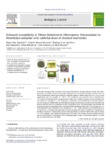Por favor, use este identificador para citar o enlazar este ítem:
http://www.alice.cnptia.embrapa.br/alice/handle/doc/959159Registro completo de metadatos
| Campo DC | Valor | Lengua/Idioma |
|---|---|---|
| dc.contributor.author | QUINTELA, E. D. | pt_BR |
| dc.contributor.author | MASCARIN, G. M. | pt_BR |
| dc.contributor.author | SILVA, R. A. da | pt_BR |
| dc.contributor.author | BARRIGOSSI, J. A. F. | pt_BR |
| dc.contributor.author | MARTINS, J. F. da S. | pt_BR |
| dc.date.accessioned | 2013-10-19T00:07:33Z | - |
| dc.date.available | 2013-10-19T00:07:33Z | - |
| dc.date.created | 2013-06-03 | pt_BR |
| dc.date.issued | 2013 | pt_BR |
| dc.identifier.citation | Biological Control, v. 66, p. 56-64, 2013. | pt_BR |
| dc.identifier.uri | http://www.alice.cnptia.embrapa.br/alice/handle/doc/959159 | pt_BR |
| dc.description | This study investigated the interaction of the fungus Metarhizium anisopliae (Metsch.) Sorok. with sublethal doses of synthetic chemical insecticides thiamethoxam and lambda-cyhalothrin for the control of Tibraca limbativentris adults under laboratory and field conditions. Median lethal time (LT50) was reduced significantly when M. anisopliae (5 x 106?5 x 108 conidia/mL) was combined with a sublethal dose (0.77 ppm AI) of thiamethoxam compared with fungus only. A similar response on host mortality was observed for M. anisopliae at 5 x 107 conidia/mL in combination with sublethal dose of lambda-cyhalothrin at 9.33 ppm (AI). Additionally, the thiamethoxam-fungus combination increased overall mortality and percent mycosed insects in comparison to their counterparts alone. Increasing fungus concentration did not increase insect susceptibility when combined with thiamethoxam either at 0.77 or 0.38 ppm (AI). In a field experiment, the combination of M. anisopliae at 1 x 1012 viable conidia/ha with thiamethoxam at 12.5 g (AI)/ha (1=4 full dose) synergistically increased mortality and mycosis of adults of T. limbativentris. Therefore, enhanced T. limbativentris control could potentially be achieved within label rates of fungus (5 x 106 conidia/mL) and sublethal thiamethoxam (0.77 ppm). The strategy of using sublethal doses of chemical insecticides in combination with entomopathogenic fungi is a promising approach to battle the rice stalk stink bug in rice fields. | pt_BR |
| dc.language.iso | eng | eng |
| dc.rights | openAccess | eng |
| dc.subject | Biocontrol | pt_BR |
| dc.subject | Rice stalk stink bug | pt_BR |
| dc.title | Enhanced susceptibility of Tibraca limbativentris (Heteroptera: Pentatomidae) to Metarhizium anisopliae with sublethal doses of chemical insecticides. | pt_BR |
| dc.type | Artigo de periódico | pt_BR |
| dc.date.updated | 2013-10-19T00:07:33Z | pt_BR |
| dc.subject.thesagro | Arroz | pt_BR |
| dc.subject.thesagro | Oryza sativa | pt_BR |
| dc.subject.thesagro | Tibraca limbativentris | pt_BR |
| dc.subject.thesagro | Metarhizium anisopliae | pt_BR |
| dc.subject.thesagro | Inseticida | pt_BR |
| dc.subject.nalthesaurus | entomopathogenic fungi | pt_BR |
| riaa.ainfo.id | 959159 | pt_BR |
| riaa.ainfo.lastupdate | 2013-10-18 | pt_BR |
| dc.identifier.doi | http://dx.doi.org/10.1016/j.biocontrol.2013.03.018 | pt_BR |
| dc.contributor.institution | ELIANE DIAS QUINTELA, CNPAF; GABRIEL MOURA MASCARIN, CNPAF; RODRIGO ALVES DA SILVA, CNPAF; JOSE ALEXANDRE F BARRIGOSSI, CNPAF; JOSE FRANCISCO DA SILVA MARTINS, CPACT. | pt_BR |
| Aparece en las colecciones: | Artigo em periódico indexado (CNPAF)  | |
Ficheros en este ítem:
| Fichero | Descripción | Tamaño | Formato | |
|---|---|---|---|---|
| Tibraca.pdf | 1.2 MB | Adobe PDF |  Visualizar/Abrir |









